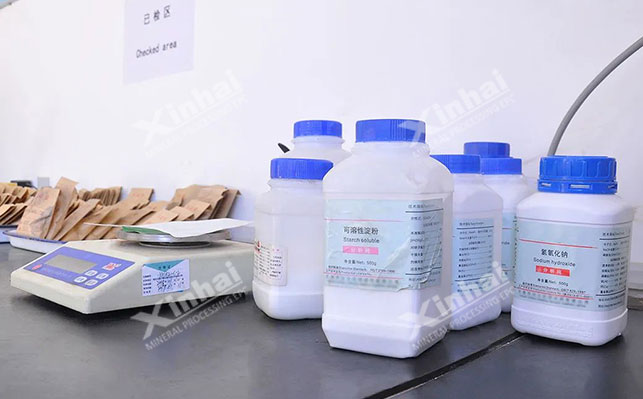
15311826613
Click to add WeChatThe function of spodumene flotation agents is to make the spodumene surface hydrophobic by adjusting the pulp environment and changing the surface properties of the minerals, so as to achieve separation from the gangue minerals, inhibit the gangue minerals, generate stable bubbles, and help improve the grade and recovery rate of spodumene concentrate. Commonly used reagents are collectors, adjusters and frothers.
Spodumene flotation collectors form a hydrophobic film on the surface of spodumene by chemical adsorption or electrostatic adsorption with the metal ions on the surface of spodumene, enhance the hydrophobicity of the spodumene surface, enable it to attach to the bubbles, and separate it from the pulp to improve the grade and recovery rate of spodumene concentrate. Commonly used collectors are mainly fatty acids (oleic acid and soaps), amines (dodecylamine, octadecylamine) and chelating collectors (hydroxamic acids).

Fatty acid collectors: oleic acid and soaps. In the pulp, oleic acid soap can effectively adsorb on the surface of spodumene to enhance its floatability. However, this type of collector is interfered by gangue minerals such as feldspar and mica, which will affect its selectivity.
Amine collectors: There is dodecylamine, whose cations can electrostatically adsorb with the negative charges on the surface of gangue minerals such as quartz, making the surface of gangue minerals hydrophobic and floating, thereby separating spodumene from gangue minerals. For the flotation of silicon-containing spodumene, amine collectors are often used in reverse flotation operations.
Chelating collectors: There are hydroxamic acid chelating collectors, which have good selectivity and collection ability for spodumene, can form stable chelates with metal ions on the surface of spodumene, firmly adsorb on the mineral surface, and enhance the hydrophobicity of spodumene.
Common adjusters for spodumene flotation are used to regulate the pulp environment and improve the flotation effect of spodumene. Commonly used adjusters are mainly pH adjusters, inhibitors and activators.

pH adjuster: Sulfuric acid is a commonly used acidic pH adjuster. Before spodumene flotation, the pH value of the pulp can be adjusted to the acidic range, generally around 5-7. Acidic environment helps to inhibit gangue minerals and enhance the effect of spodumene and collectors. For example, in the flotation of some lithium mica-type lithium ores, after adjusting the pH value with sulfuric acid, the floatability of spodumene is enhanced, and the amount of fatty acid collectors can be reduced. Alkaline pH adjusters such as sodium carbonate can adjust the pH value of the pulp to alkaline and are used to inhibit some gangue minerals. For example, when treating spodumene ores containing more mica, appropriately increasing the pH value of the pulp can reduce the floatability of mica and reduce its interference with spodumene flotation.
Inhibitor: Water glass is an important inhibitor in spodumene flotation, and has a good inhibitory effect on gangue minerals such as quartz and feldspar. Water glass hydrolyzes in the pulp to produce silicate ions, which can form a hydrophilic film on the surface of gangue minerals, reducing their floatability, but has little effect on spodumene. In the spodumene flotation process, the reasonable addition of water glass can effectively improve the grade of spodumene concentrate. In addition, sodium hexametaphosphate can also be used as an inhibitor, which is often used to inhibit calcium-containing gangue minerals. When treating spodumene ore containing calcium-containing gangue such as calcite, adding sodium hexametaphosphate can selectively inhibit calcite and ensure the flotation effect of spodumene.
Activator: It can enhance the adsorption capacity of the mineral surface to the collector. When there are some oxide films or impurities on the surface of spodumene, which affect the adsorption effect of the collector, adding an activator (such as copper sulfate, etc.) can replace or chemically react with the ions on the surface of the mineral, remove the oxide film or impurities, and expose the fresh mineral surface, thereby improving the adsorption performance of spodumene to the collector and enhancing its floatability.
In spodumene flotation, frothers are commonly used to generate bubbles by reducing the surface tension of the gas-liquid interface to assist in the flotation of spodumene. Commonly used frothers include pine oil, methyl isobutyl carbinol and octanol.

Pine oil: Pine oil is a common foaming agent for spodumene flotation, with the characteristics of strong foaming ability and stable foam. In the pulp, pine oil can reduce the surface tension of the gas-liquid interface, promote the generation and stable existence of bubbles. The bubbles it produces are of moderate size, which is conducive to the floating of hydrophobic spodumene particles. In most spodumene flotation plants, pine oil is widely used. By adjusting its addition amount, the thickness and stability of the foam layer can be controlled to optimize the flotation effect.
Methyl isobutyl carbinol (MIBC): MIBC is also a commonly used foaming agent. Compared with pine oil, the foam it produces is more brittle and the defoaming speed is relatively fast. In some spodumene flotation processes that have special requirements for foam performance, MIBC can be used in combination with pine oil to adjust the foam properties. For example, in the case of rapid scraping of bubbles and reduction of gangue entrainment, the appropriate addition of MIBC can improve the flotation index and improve the quality of spodumene concentrate.
2-Octanol: 2-Octanol as a foaming agent has good foaming performance and can form stable bubbles in the pulp. It has strong adaptability to the spodumene flotation system and can function under different pulp properties. When treating some spodumene ores containing special gangue minerals, 2-octanol shows good selectivity, which improves the recovery rate while ensuring the grade of spodumene concentrate.